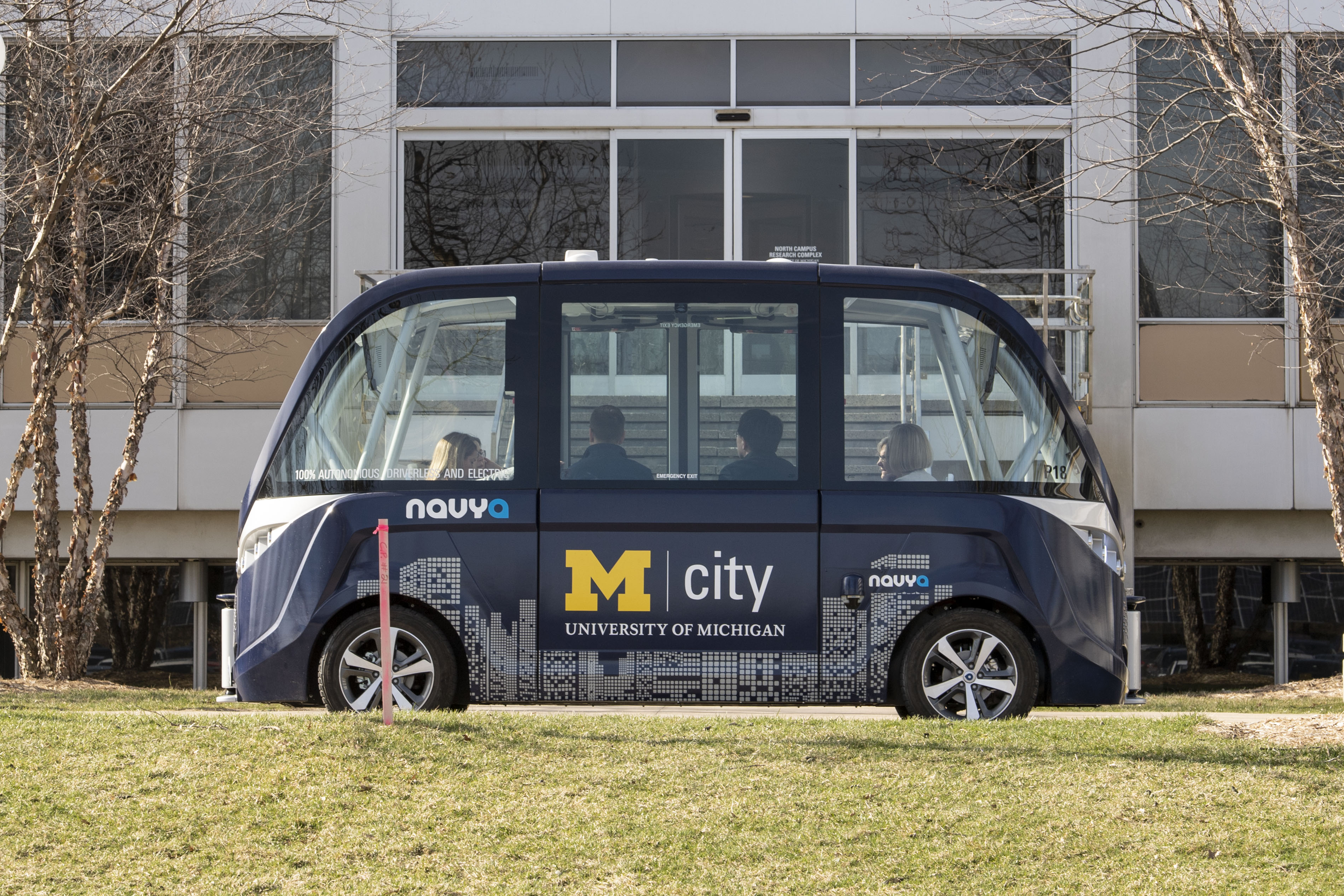Mcity Driverless Shuttle: The Human Side of AV Tech

The Mcity Driverless Shuttle arrives at The Henry Ford.
Thanks to a generous gift from the University of Michigan (U-M), The Henry Ford recently acquired its second autonomous vehicle: a driverless shuttle used by U-M’s Mcity connected and automated vehicle research center. Readers may recall that we acquired our first AV in 2018 – a 2016 General Motors Self-Driving Test Vehicle. While the GM car was an experimental vehicle focused on technology, the Mcity shuttle took part in an intriguing project more focused on the psychology of consumer trust and acceptance of driverless vehicles.
From June 4, 2018, through December 13, 2019, Mcity, a public-private research partnership led by U-M, operated this driverless shuttle at U-M’s North Campus Research Complex in Ann Arbor. The project’s purpose was to understand how passengers, pedestrians, bicyclists, and drivers interacted with autonomous vehicles. In effect, the project was a way to gauge consumer acceptance of a decidedly unconventional new technology.
The shuttle donated to The Henry Ford is one of two fully-automated, electrically-powered, 11-seat shuttles Mcity operated on a fixed route around the research complex throughout the course of the study. The shuttles were built by French manufacturer Navya. In late 2016, Navya had delivered its first self-driving shuttle in North America to Mcity, where it was used to support research and to demonstrate automated vehicle technology. In June 2017, Mcity announced plans to launch a research project in the form of an on-campus shuttle service that would be open to the U-M community.
The Mcity Driverless Shuttle operated on a one-mile loop around the North Campus Research Complex at speeds averaging about 10 miles per hour. The service ran Monday-Friday from 9 AM to 3 PM. While its route avoided heavy-traffic arteries, the shuttle nevertheless shared two-way public roadways with cars, bicycles, and pedestrians. It operated in a variety of weather conditions, including winter cold and snow; but was not used in more extreme weather, such as heavy snow or rain.
The Mcity Driverless Shuttle on its route at the University of Michigan’s North Campus Research Complex. (Photo credit: University of Michigan)
While the shuttle and its technology are impressive enough, the impetus behind its use is arguably more important to The Henry Ford. The Mcity research project was the first driverless shuttle deployment in the United States that focused primarily on user behavior. Mcity’s goal was to learn more about how people reacted to AVs, rather than prove the technology. The two shuttles were equipped with exterior video recorders to capture reactions from people outside the shuttle, and interior video and audio recorders to capture reactions from passengers inside. On-board safety conductors, there to stop the shuttle in case of emergency, also observed rider behavior.
Mcity staff monitored ridership numbers and patterns throughout the project, and riders were encouraged to complete a survey about their experience that was developed by Mcity and the market research firm J.D. Power. Survey questions ranged from basic inquiries about age and relationship to the university, to more specific inquiries about reasons for riding, degree of satisfaction with the service, interest level in AV technology, and – most significantly – degree of trust in the shuttle and its driverless capabilities. The survey data was then analyzed by J.D. Power. You can learn more about the results through Mcity's white paper, "Mcity Driverless Shuttle: What We Learned About Consumer Acceptance of Automated Vehicles."
Along with the shuttle itself, U-M has kindly donated examples of the special signage installed by Mcity in support of the shuttle project. There are no current government regulations – at the federal, state, or local levels – for signage along a driverless vehicle route. Mcity developed its own signs to alert other road users to the shuttle’s presence. Samples include signs proclaiming “Shuttle Stop” and “Attention: Driverless Vehicle Route.”
Autonomous vehicles are coming to our streets – it’s no longer a question of “if,” but of “when.” Indeed, the Mcity shuttle project proves that AVs are, to an extent, already here. These driverless vehicles promise to be the most transformative development in ground transportation since the automobile itself. Self-driving capabilities will fundamentally change our relationship with the vehicle. The technology promises improved safety and economy in our cars and buses, greater capacity and efficiency on our roads, and enhanced mobility and quality of life for those unable to drive themselves. The Mcity Driverless Shuttle represents an important milestone on the road to autonomy, and it marks an important addition to The Henry Ford’s automotive collection.
See the Mcity Driverless Shuttle in action in this video. (Video credit: University of Michigan)
Matt Anderson is Curator of Transportation at The Henry Ford.
21st century, 2010s, technology, research, Michigan, by Matt Anderson, autonomous technology, alternative fuel vehicles


Facebook Comments